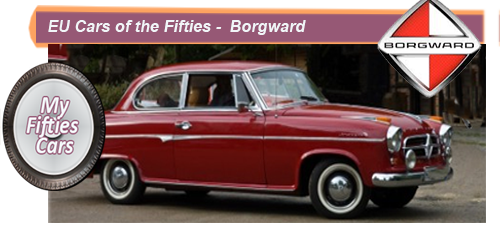
 Carl Friedrich Wilhelm Borgward, founder of Carl F. W. Borgward Automobile- und Motorenwerke factory was born in 1890, in a Hamburg, Germany one of twelve children to middle-class parents.
Carl Friedrich Wilhelm Borgward, founder of Carl F. W. Borgward Automobile- und Motorenwerke factory was born in 1890, in a Hamburg, Germany one of twelve children to middle-class parents.
With no chance of reaching university due to financial constraints, Carl finished school at the age of just sixteen, to become an apprentice locksmith.
Borgward’s apprenticeship as a locksmith soon came to a close due to the demands of the war effort in Germany, instead of joining a very large Hamburg company that produced tyres, later diversifying to produce radiators and body panels as sub-contractors for the massive Bremen based engineering giants Hansa-Lloyd,
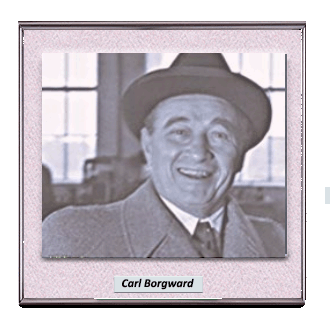 In 1914 Hansa-LLOYD which had merged with the equally titanic Norddeutsche Automobil und Motoren AG (NAMAG) car manufacturers to form Hansa-Lloyd-Werke A.G.
In 1914 Hansa-LLOYD which had merged with the equally titanic Norddeutsche Automobil und Motoren AG (NAMAG) car manufacturers to form Hansa-Lloyd-Werke A.G.
The young and ambitious Carl soon found himself climbing up the ladder a Hansa-Lloyd-Werke A.G, until he decided that the time was right to set up his own concern, under the title of the
Kuhlerfabrik Borgward and Co. G.m.b.H. in Bremen, or Goliath trucks for short.
Borgward’s original intention was to go into car production, but his plans were continuously hampered due to a lack of financial resources.
In 1924 his company did make a breakthrough when they were awarded a contract by the German post office to produce a 120cc engine, single front wheel delivery scooter which they named the 'Blitzkarren'.
![]()
The success of the 'Blitzkarren' led to Goliath producing a series of light vans and trucks, and the company became among the leaders in their field.
By 1930, Borgward had accumulated sufficient capital to acquire the financially flagging Hansa-Lloyd-Werke A.G group, meaning that Carl’s dream to become a fully-fledged car manufacturer became a reality.
The first Bo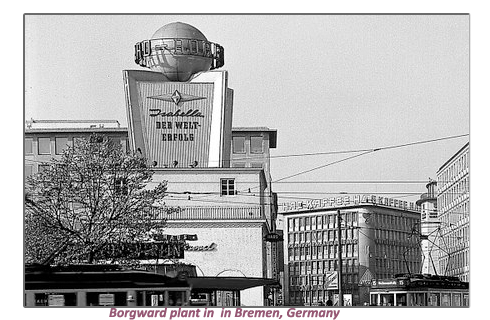 rgward four-wheeled motor car to run off the production line was the Hansa 400/500.
rgward four-wheeled motor car to run off the production line was the Hansa 400/500.
1934 saw the release of two new Hansas, the 1100, powered by a four-stroke engine and the larger and more powerful 1700 engined version.
Both of these models were available as Sedans and Cabriolets.
A twin carburetted 1700 Sport-Cabriolet version enjoyed particular success.
As part of Carl Borgward’s extensive expansion program, the Hansa range was further enlarged in 1938 with the launch of the Hansa 2000cc and Hansa 3500cc engined versions.
In 1939, with Hansas selling well across the board, Carl took the bold step of rebranding all of the model range to be marketed under the Borgward label.
With his com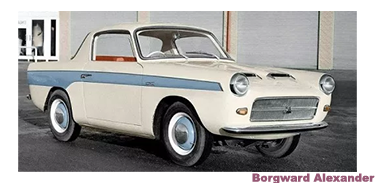
 pany riding an unprecedented wave of success, Carl Borgward had to put everything on hold to play their part in Germany’s war effort.
pany riding an unprecedented wave of success, Carl Borgward had to put everything on hold to play their part in Germany’s war effort.
After their plants suffered significant damage during the war, it took Borgward three years to get back into production. At the Geneva auto show in 1949 came the debut of the Borgward Hansa 1500, which was the first West German car to enter production after the war.
![]()
The Borgward Hansa 1500 was the first post-war West German automobile to hit the market. Powered by a 91 cubic-inch four-cylinder engine, the Hansa 1500 carried the customary diamond-shaped grille centre, half of which extended upward into the hood area.
 That was followed by the 1800 and the six-cylinder 2400. Claimed to have a top speed near 100 mph, the six-cylinder model was eventually offered with in-house developed “Hansamatic” transmission.
That was followed by the 1800 and the six-cylinder 2400. Claimed to have a top speed near 100 mph, the six-cylinder model was eventually offered with in-house developed “Hansamatic” transmission.
Borgward’s best-known model of the Fifties was undoubtedly the Isabella, which entered production late in 1954. The Isabella was a unibodied version of the H 1500. Among a long list of technical advances, the Borgward Isabella came with independent suspension on all four wheels.
Despite appa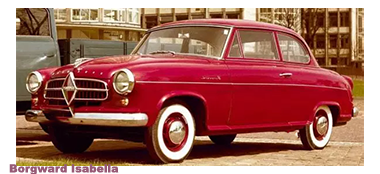 rently enjoying joining financial success and with demand high for their products, Borgward began to show signs of economic instability in the late Fifties, which came to a head in 1961 when the company was forced into liquidation by its creditors.
rently enjoying joining financial success and with demand high for their products, Borgward began to show signs of economic instability in the late Fifties, which came to a head in 1961 when the company was forced into liquidation by its creditors.
Carl Borgward was forced to face the humiliation of being ignominiously dismissed from the company that he had founded and built up into an empire during his lifetime.
 A broken man, Borgward passed away just two years later, still insisting the company had been finically solvent at the time of its liquidation.
A broken man, Borgward passed away just two years later, still insisting the company had been finically solvent at the time of its liquidation.
When Borgward’s affairs were finally wound down, it was discovered that they were several million Deutschmarks to the good after all accounts had been settled.

